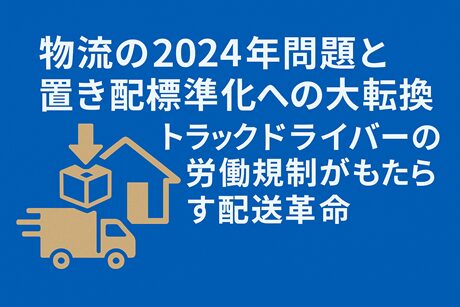目次
- 1 Japan’s 2024 Logistics Crisis: The Delivery Revolution
- 1.1 The Complex Crisis Facing Japan’s Logistics Industry: Understanding the 2024 Problem
- 1.2 Defining Unattended Delivery: A New Standard for Non-Contact Delivery
- 1.3 The Multifaceted Benefits of Unattended Delivery: Achieving Win-Win-Win
- 1.4 Challenges and Concerns with Unattended Delivery: Addressing Security Risks
- 1.5 Latest Security Technologies and Systems
- 1.6 Expansion of Open-Type Parcel Lockers and Convenience Store Pickup
- 1.7 Challenges and Measures for Unattended Delivery in Apartments and Condominiums
- 1.8 Types of Parcel Lockers and Latest Technologies
- 1.9 Industry Transformation through Logistics DX and Standardization
- 1.10 Labor Shortage Countermeasures and Logistics Structure Reform
- 1.10.1 Reviewing Business Customs and Improving Transaction Environments
- 1.10.2 Penetration of Standard Freight Rates and Collection of Appropriate Compensation
- 1.10.3 Correcting Multi-Layered Subcontracting Structures
- 1.10.4 Work Reform and Labor Environment Improvement
- 1.10.5 Securing and Utilizing Diverse Human Resources
- 1.11 Modal Shift and Transportation Method Diversification
- 1.12 Maintaining Logistics Functions in Depopulated Areas
- 1.13 Building Resilient and Sustainable Logistics Networks
- 1.14 Visualizing Logistics Costs and New Pricing Systems
- 1.15 Initiatives to Promote Consumer Behavioral Change
- 1.16 International Perspective: Foreign Initiatives and Implications for Japan
- 1.17 Future Outlook: Vision for Logistics Toward 2030
- 1.18 Measures Companies Should Take Immediately
- 1.19 Conclusion: Building a Sustainable Logistics System
Japan’s 2024 Logistics Crisis: The Delivery Revolution
On April 1, 2024, Japan’s logistics industry will face a historic turning point. The implementation of work reform laws limiting truck drivers’ overtime to 960 hours annually – known as the “2024 Problem” – threatens to eliminate approximately 14% of current transport capacity.
In response to this unprecedented crisis, Japan’s Ministry of Land, Infrastructure, Transport and Tourism (MLIT) is advancing new regulations to make “unattended delivery” (okihai) the standard delivery method. In the future, face-to-face delivery may incur additional charges, regardless of whether recipients are home. How will this bold policy shift impact our daily lives?
The Complex Crisis Facing Japan’s Logistics Industry: Understanding the 2024 Problem
Japan’s logistics infrastructure, essential for supporting daily life and economic activity, now faces a multifaceted crisis threatening its very foundation.
The Severity of Labor Shortages
Truck drivers’ working conditions are significantly harsher compared to other industries. The average age is approximately 50, about 5 years older than the all-industry average, with minimal youth recruitment. Annual working hours reach about 2,600 hours – approximately 400 hours more than the industry average – normalizing extreme working conditions.
Even more serious are the extended waiting times. Drivers are frequently forced to wait for hours due to shippers’ convenience, becoming a major factor in prolonged working hours and decreased productivity. Non-contractual supplementary work (such as forklift operations) further burdens drivers.
Explosive Growth in Delivery Demand from E-commerce Expansion
The e-commerce market reached approximately 23 trillion yen in 2022 and continues expanding annually. This growth has led to a surge in parcel delivery volumes, particularly small, frequent deliveries. The COVID-19 pandemic accelerated this trend through increased stay-at-home consumption.
Meanwhile, “free shipping” has become entrenched as a competitive strategy among e-commerce businesses, embedding logistics costs within product prices and transferring the burden to delivery companies. This structure has compressed profit margins, making it difficult to invest in driver compensation improvements or new hiring.
The Serious Social Waste of Redelivery
Parcel redelivery rates average approximately 11.8% nationwide, reaching about 15% in urban areas. This redelivery wastes approximately 180 million labor hours annually and produces about 60,000 tons of excess CO2 emissions. The social loss from redelivery is estimated at approximately 180 billion yen annually.
Particularly problematic is “hidden redelivery.” While signature-free medium-sized packages have increased, many don’t fit in mailboxes, requiring face-to-face delivery and resulting in redelivery when recipients are absent.
Multi-layered Subcontracting Structure Creating Excessive Field Burden
The trucking industry features a multi-layered subcontracting structure. As work flows from shippers to primary contractors, then to subcontractors and sub-subcontractors, margins are taken at each stage, drastically reducing the fees ultimately received by field drivers. This structure places excessive burden on actual drivers and small-to-medium transport companies.
Additionally, negotiating power disparities with shippers prevent appropriate freight rate collection. Small and medium transport companies, particularly, are in weak positions relative to major shippers, often forced into unfavorable contract terms.
Defining Unattended Delivery: A New Standard for Non-Contact Delivery
“Unattended delivery” (okihai) refers to completing delivery by leaving packages at pre-designated locations without face-to-face interaction with delivery personnel. This delivery method represents a fundamentally different approach from traditional hand-to-hand delivery.
Detailed Locations Available for Unattended Delivery
Available locations vary by delivery company but primarily include:
- Front door: The most common unattended delivery location, placed in front of or beside doors
- Parcel lockers: Dedicated receiving boxes with high security through locking features
- Gas meter boxes: Semi-enclosed spaces protecting from rain and wind
- Bicycle baskets: Limited to small packages but convenient receiving locations
- Garages: Relatively safe unattended delivery locations for detached homes
- Storage sheds: Utilizing outdoor storage spaces for receiving
- Building reception desks: Alternative receiving method for apartment complexes
Establishment of the Unattended Delivery Committee and Policy Background
MLIT and the Ministry of Economy, Trade and Industry (METI) established the “Unattended Delivery Committee” in 2019, summarizing the current state and implementation points for unattended delivery. This committee includes academics, logistics operators, e-commerce businesses, and consumer groups, comprehensively examining challenges and countermeasures for promoting unattended delivery.
The committee positions unattended delivery not merely as a countermeasure to the 2024 Problem but as an important measure for ensuring logistics sustainability. Future considerations include making unattended delivery the standard delivery method and introducing “menu pricing” that charges additional fees for face-to-face delivery requests.
The Multifaceted Benefits of Unattended Delivery: Achieving Win-Win-Win
Unattended delivery is attracting attention as a “win-win-win” solution bringing substantial benefits to consumers, delivery companies, and society as a whole.
Benefits for Delivery Companies: Achieving Efficiency and Cost Reduction
Dramatic Reduction in Redelivery: Completing delivery in one attempt significantly reduces redelivery efforts. This is estimated to increase the number of packages one driver can deliver daily by approximately 20%.
Substantial Reduction in Personnel and Operating Costs: Costs associated with redelivery – including personnel expenses, fuel costs, vehicle maintenance, and package storage space – are reduced. One major delivery company estimates that introducing unattended delivery can reduce delivery costs by approximately 15%.
Reducing Driver Burden and Achieving Work Reform: Decreased redelivery and waiting time at delivery destinations shortens driver working hours, improving long working hour conditions. This serves as a direct countermeasure to the 2024 Problem.
Delivery Route Optimization: Eliminating the need to consider redelivery enables more efficient delivery route design, improving overall delivery efficiency.
Consumer Benefits: Convenience and Stress-Free Receiving
Complete Liberation from Time and Location Constraints: No need to stay home for package receipt, eliminating the need to adjust work or outing schedules. This dramatically improves lifestyle freedom, particularly for single-person and dual-income households.
Elimination of Receiving Stress: No face-to-face interaction with delivery personnel eliminates stress about appearance or doorstep conversations. Packages can be received regardless of being in pajamas or bathing.
Consideration for Households with Children: No worry about doorbells waking napping babies, particularly important for households with young children.
Peace of Mind with Non-Contact, Non-Face-to-Face Delivery: Following the COVID-19 pandemic, demand for non-contact receiving has increased, and unattended delivery completely meets this need.
Environmental Contributions: Realizing a Sustainable Society
Substantial CO2 Emission Reduction: Reduced redelivery shortens delivery vehicle travel distances, expected to reduce annual CO2 emissions by approximately 30,000 tons. This is equivalent to annual CO2 emissions from approximately 13,000 households.
Traffic Congestion Relief: Particularly in urban areas, reducing excess delivery vehicle travel from redelivery contributes to traffic congestion relief.
Energy Resource Conservation: Reduced fuel consumption contributes to conserving limited fossil fuel resources, important from an energy security perspective.
Ripple Effects on Regional Economies
Increased installation and use of parcel lockers raises demand for related products and services, potentially creating new business opportunities and employment. Markets for parcel locker manufacturing, installation construction, and maintenance services are actually expanding.
Challenges and Concerns with Unattended Delivery: Addressing Security Risks
While unattended delivery offers many benefits, several important challenges and concerns exist. Consumer surveys reveal that 77.1% of those anxious about unattended delivery are most worried about “package theft.”
Theft Risk and Its Reality
The risk of unattended package theft increases particularly in the following situations:
- When packages are left for extended periods in visible locations from the street, such as in front of detached homes
- Delivery of high-value or popular items (latest smartphones, gaming consoles, etc.)
- Long periods between delivery and collection
- Use in areas with low foot traffic or poor security
In the United States, “porch pirates” who steal packages from doorsteps have become a social problem, raising concerns about similar crimes increasing in Japan. In Aichi Prefecture, items mistakenly delivered and turned in to police jumped 38-fold from 30 items in 2019 to 1,140 items in 2024, straining police operations.
Risk and Impact of Misdelivery
Non-face-to-face delivery prevents delivery personnel from confirming recipients, creating the following misdelivery risks:
- Misdelivery to similar addresses (wrong apartment numbers, wrong street numbers, etc.)
- Floor mistakes in apartment buildings
- Delivery mistakes at homes without nameplates
When misdelivery occurs, redelivery to the correct address takes time and effort, potentially decreasing customer satisfaction and damaging trust.
Risk of Damage and Contamination
Packages left outdoors may suffer the following damage:
- Weather damage: Getting wet, deformation from rain, snow, strong winds, or direct sunlight
- Animal damage: Package damage or contamination from crows, cats, dogs, etc.
- Dirt: Contamination from mud splashes, dust, pollen, etc.
Particularly for food items, many people feel hygiene concerns about direct ground placement, presenting quality maintenance challenges.
Privacy and Security Concerns
Unattended delivery creates the following privacy and security concerns:
- Risk of absence being apparent from package presence
- Personal information exposure from exposed address labels
- Risk of planned crimes from understanding high-value item delivery patterns
Latest Security Technologies and Systems
Various technological and institutional measures are being developed and introduced to address these challenges.
Evolution of IoT Parcel Lockers
The latest IoT parcel lockers feature the following advanced functions:
- Smartphone integration: Receive delivery notifications via dedicated apps, enable remote unlocking
- Barcode authentication: Appropriate boxes open automatically using delivery slip barcodes
- Built-in cameras: Record and save delivery scenes as evidence for troubles
- Temperature and humidity management: Sensors monitor internal environment, contributing to quality maintenance
- Multiple authentication methods: Various unlocking methods including PIN codes, IC cards, fingerprints, and facial recognition
Furthermore, models equipped with V2H (Vehicle to Home) devices and solar power generation functions are appearing, contributing to emergency power supply during disasters and environmental load reduction.
Introduction of Unattended Delivery Insurance and Coverage Details
The “unattended delivery insurance” jointly developed by Tokio Marine & Nichido Fire Insurance and Yper is attracting attention as a groundbreaking compensation service:
- Coverage details: Compensates up to 30,000 yen for theft of packages received in the “OKIPPA” unattended delivery bag
- Coverage conditions: Theft within 24 hours of delivery completion
- Procedures: Requires filing a theft report with police
- Insurance premium: Included in OKIPPA purchase price, no additional fees required
This insurance allows consumers to use unattended delivery without worrying about theft risks.
Integration with Security Services
Security companies like ALSOK (Sohgo Security Services) provide services specialized for unattended delivery:
- Self-security services: Remote monitoring of home conditions via smartphone apps
- Anomaly detection systems: Immediate notification upon detecting suspicious movements
- Dispatch services: Guards rush to the scene when necessary
- Security camera integration: Focused monitoring of unattended delivery areas
Measures by E-commerce Companies
Major e-commerce companies like Rakuten and Amazon are implementing their own measures:
- Product restrictions: High-value items, pharmaceuticals, cash-on-delivery packages excluded from unattended delivery
- Delivery option segmentation: Automatic selection of optimal delivery methods by product and region
- Compensation systems: Reshipment or refund support for theft/loss during unattended delivery
- Delivery completion photos: Delivery personnel photograph unattended delivery completion as evidence
Expansion of Open-Type Parcel Lockers and Convenience Store Pickup
For consumers anxious about home unattended delivery, safer alternatives are being expanded.
Proliferation of Open-Type Parcel Lockers
Open-type parcel lockers installed at stations, supermarkets, convenience stores, parking lots, and public facilities offer the following benefits:
- 24-hour pickup availability: Can be collected at user convenience
- High security: Eliminates theft risk through locked individual boxes
- Multi-carrier compatibility: Can collect packages from different delivery companies together
- Non-contact pickup: Enables completely non-face-to-face collection
Kyocera’s developed system allows delivery personnel to check and reserve parcel locker availability via mobile devices, achieving efficient delivery. The advantage is implementation by simply installing antennas on existing communication-enabled parcel lockers and updating software.
Convenience of Convenience Store Pickup Services
Pickup services at approximately 58,000 convenience stores nationwide feature:
- Pickup possible along daily routes near work or home
- Reduced misdelivery risk through store staff identity verification
- Support for refrigerated/frozen items (select stores)
- Contribution to store sales through impulse purchases
Challenges and Measures for Unattended Delivery in Apartments and Condominiums
Introducing unattended delivery in multi-unit housing presents unique challenges different from detached homes.
Addressing Auto-Lock Condominiums
Auto-lock condominiums present the fundamental problem of delivery personnel being unable to pass through entrances. The following technological solutions are being developed:
Smart Key Systems:
- Residents grant temporary entrance unlocking via dedicated apps
- One-time passwords sent to delivery personnel smartphones
- Enables delivery personnel entry while maintaining security
Auto-Lock Condominium Entrance Unlocking System (Developed by Yper):
- Tokenizes delivery slip numbers to safely transmit unlocking information
- Universal system not dependent on major carriers
- Compatible with existing auto-lock systems
However, these systems have challenges. Since delivery personnel must travel to each unit, delivery efficiency may decrease compared to entrance parcel locker delivery due to increased time requirements.
Management Rule Revisions and Consensus Building
MLIT recommends clearly defining the following matters in management rules or usage regulations for unattended delivery implementation in condominiums:
Example Usage Regulations for Unattended Delivery:
- Available hours: 8:00 AM to 8:00 PM (noise prevention at night)
- Permitted unattended delivery locations:
- In front of each unit’s door (only areas with exclusive use rights)
- Within half the corridor width
- Positions not obstructing evacuation routes
- Abandonment period restrictions:
- Collection required within delivery day as principle
- Abandonment over 24 hours prohibited
- Management association can dispose of long-term abandoned items
- Prohibited items:
- Items with hygiene problems like garbage
- Items emitting odors
- Dangerous or flammable materials
- Large items obstructing passage
- Liability allocation:
- Users bear responsibility for theft, damage, etc. from unattended delivery use
- Management associations and management companies bear no responsibility
Relationship with Fire Prevention Laws
Fire prevention laws prohibit abandoning items that obstruct evacuation in corridors, stairs, and emergency exits. However, according to MLIT’s interpretation, “temporarily placing small amounts or small-scale personal items” generally doesn’t violate fire prevention laws.
However, this interpretation may vary by municipality and fire department, so management associations are recommended to confirm with local fire departments in advance.
Types of Parcel Lockers and Latest Technologies
Parcel lockers are rapidly spreading as important infrastructure enhancing unattended delivery safety. In the National Rental Housing Newspaper’s “Popular Amenities for Tenants Ranking,” they ranked 6th, surpassing reheating functions and intercom monitors, becoming recognized as “standard equipment,” particularly among younger demographics.
Evolution of Parcel Lockers for Detached Homes
Freestanding Type:
- Price range: 30,000-150,000 yen
- Materials: Steel, stainless steel, reinforced resin, etc.
- Functions: Mechanical locks, electronic locks, smart lock compatible
- Installation: Fixed with anchor bolts, movable
Built-in Type:
- Price range: 100,000-300,000 yen
- Features: Built into gate posts or walls, high design quality
- Functions: Large capacity, models capable of receiving multiple items
- Benefits: Extremely low theft risk
Latest High-Function Models:
- V2H device-equipped type: Enables power interchange with electric vehicles
- Solar power generation integrated type: Usable during power outages with independent power source
- Refrigeration/freezing function equipped: Compatible with food unattended delivery (under development)
- AI camera equipped: Suspicious person detection, facial recognition functions
Large-Scale Parcel Lockers for Multi-Unit Housing
Mechanical Type (Dial Lock Type):
- Price range: 500,000-2,000,000 yen (for 10 households)
- Features: No power required, simple maintenance
- Challenges: PIN code management, tendency to fill quickly
Electric Type (Computer-Controlled Type):
- Price range: 2,000,000-5,000,000 yen (for 50 households)
- Functions:
- Touch panel operation
- IC card, barcode authentication
- Package tracking system integration
- Real-time availability information distribution
- 24-hour remote monitoring
- Benefits: Efficient management of large package volumes
Next-Generation Smart Parcel Lockers:
- Facial recognition system: Latest AI capable of recognition even when wearing masks
- Voice guidance function: Consideration for visually impaired users
- Multi-language support: Responding to increasing foreign residents
- Cloud management: Enables centralized management of multiple properties
Features and Limitations of Simple Parcel Boxes/Bags
Foldable Delivery Bags:
- Price range: 3,000-10,000 yen
- Features:
- Compact storage when not in use
- Fixed to door handles etc. with wire locks
- Water-repellent coating handles light rain
- Benefits: Can be installed in rental housing, low initial cost
- Disadvantages:
- Low security (can be cut with cutters)
- Vulnerable to heavy rain and strong winds
- Cannot accommodate large packages
- Risk of revealing absence
Industry Transformation through Logistics DX and Standardization
The spread of unattended delivery is positioned as an important part of the logistics industry’s overall digital transformation (DX). MLIT aims for fundamental productivity improvements through logistics DX in the “Comprehensive Logistics Policy Guidelines (2021-2025).”
Definition and Purpose of Logistics DX
Logistics DX is defined as “improving existing operations through mechanization and digitalization, achieving work reform, while standardizing logistics systems to improve profitability and competitiveness, innovating the business model of the logistics industry itself.”
Three Transformations Aimed at by Logistics DX:
- Improving Existing Operations and Work Reform
- Business automation and labor-saving through digital technology
- Delivery route optimization using AI
- Warehouse work efficiency through robotics
- Standardization and Systematization of Logistics Systems
- Unification of data formats
- Standardization of business processes
- Seamless information coordination between companies
- Business Model Innovation in the Logistics Industry
- Transformation to platform-based business
- Development of subscription-type logistics services
- Creation of value-added services
Promotion of Standardization and the Public-Private Logistics Standardization Conference
Standardization of various elements composing logistics is essential as a prerequisite for realizing logistics DX. MLIT has established the “Public-Private Logistics Standardization Conference” to promote cross-industry standardization of the following items:
Hardware Standardization:
- Pallet size: Promoting 1100mm×1100mm as standard
- Outer packaging size: Standardizing cardboard sizes for efficient pallet loading
- Containers/vehicles: Unifying standards to maximize loading efficiency
- Logistics equipment: Standardizing forklifts, carts, etc.
Software Standardization:
- Documents: Unifying formats for delivery notes, invoices, etc.
- Delivery codes: Code systems usable across businesses
- Data items: Standardizing EDI (Electronic Data Interchange)
- Logistics terminology: Establishing industry-common term definitions
These standardizations are expected to reduce waiting times and supplementary work, improve cargo handling efficiency, and enhance loading and storage efficiency. The processed food sector is leading standardization efforts, with plans to expand to other sectors.
Introduction of Automation and Mechanization Technologies
The following cutting-edge technologies are being rapidly introduced at logistics sites:
Warehouse Work Automation:
- Picking robots: AI image recognition accurately picks diverse products
- Sorter robots: High-speed package sorting with 10 times human processing capacity
- Palletizing/depalletizing robots: Automating heavy item loading and unloading
- AGV/AMR: Complete automation of warehouse logistics with unmanned transport vehicles
Transportation Efficiency Technologies:
- Truck reservation systems: Reducing average waiting time from 30 minutes to 5 minutes
- Vehicle tracking systems: Real-time vehicle location tracking for optimal dispatching
- AI delivery planning: Automatically generating optimal routes from traffic information, weather, and historical data
Building Data Coordination Platforms
Data coordination across the entire supply chain is central to logistics DX:
SIP Smart Logistics Service:
- Platform for collecting, storing, and analyzing logistics and commercial flow data
- Achieving overall optimization through data sharing across company boundaries
- Improving demand forecast accuracy to achieve both inventory reduction and stockout prevention
Cyber Port:
- Developed as a port-related data coordination platform
- Digitalization and simplification of import/export procedures
- Visualization of international logistics and lead time reduction
Labor Shortage Countermeasures and Logistics Structure Reform
Addressing the 2024 Problem is viewed not merely as regulatory compliance but as an opportunity to solve structural problems in the logistics industry.
Reviewing Business Customs and Improving Transaction Environments
Eliminating Long Waiting Times:
- Average waiting time: 1 hour 45 minutes (2017) → Target within 30 minutes
- Strengthening improvement requests and guidance to shippers
- Mandatory recording and “visualization” of waiting times
Standardizing Supplementary Work:
- Charging for non-contractual cargo handling work (loading, sorting, etc.)
- Focusing drivers on their primary duty (driving)
- Promoting cargo handling separation (handled by specialized staff)
Written Transportation Contracts:
- Eliminating ambiguous verbal agreements
- Clarifying scope of responsibility and fees
- Visualizing multi-layered subcontracting structures
Penetration of Standard Freight Rates and Collection of Appropriate Compensation
MLIT has announced “standard freight rates” and is promoting the following initiatives:
- Presenting appropriate levels for distance-based and time-based rates
- Clarifying waiting time fees and supplementary work charges
- Promoting introduction of fuel surcharges
- Ensuring appropriate rates reach subcontractors
This aims to raise driver wages to the all-industry average (annual income approximately 4.9 million yen). Currently, truck drivers’ average annual income is approximately 4.2 million yen, significantly below the all-industry average.
Correcting Multi-Layered Subcontracting Structures
The trucking industry’s multi-layered subcontracting structure causes the following problems:
- Actual carrier’s received rates reduced to 50-60% of prime contractor’s rates
- Unclear safety management responsibility allocation
- Deterioration of driver working conditions
Correction Measures:
- Mandatory creation of transportation system ledgers: Visualizing all subcontracting structures
- Limiting subcontracting tiers: Considering restrictions to secondary subcontracting in principle
- Direct shipper responsibility: Clarifying shipper responsibility when problems arise from multi-layered subcontracting
Work Reform and Labor Environment Improvement
Working Hour Reduction Measures:
- Promoting relay transportation:
- Multiple drivers relay long-distance transportation
- Achieving day-trip work schedules
- Improving retention rates through securing family time
- Double-trailer trucks:
- 25-meter long vehicles approximately double transportation efficiency
- Reducing required number of drivers
- Full implementation after highway demonstration experiments
- Swap body containers:
- Dramatically reducing cargo handling time through detachable cargo beds
- Reducing driver detention time
- Improving vehicle utilization rates
Rest Environment Development:
- Expanding highway SA/PA parking spaces (doubling large vehicle spaces)
- Introducing reservable parking systems
- Developing rest facilities at “Roadside Stations”
- Enhancing welfare facilities like showers and nap rooms
Securing and Utilizing Diverse Human Resources
Addressing the aging of truck drivers (average age approximately 50), the following initiatives are underway:
Promoting Female Driver Participation:
- Current: Approximately 3% of total → Target: Over 10%
- Reducing physical burden through mechanized cargo handling
- Introducing short-time work systems
- Developing women-only rest facilities
Strengthening Youth Recruitment:
- Creating semi-medium licenses (enabling 4-ton truck driving from age 18)
- Improving safety through driving support systems
- Clarifying career paths
- Creating attractive work environments using digital devices
Utilizing Foreign Workers:
- Considering acceptance through specified skill systems
- Multi-language safety education systems
- Workplace environment development including cultural considerations
Continued Employment of Elderly Workers:
- Task assignment according to physical capability
- Reassignment to short-distance delivery
- Building systems for skill transfer to younger workers
Modal Shift and Transportation Method Diversification
To eliminate excessive dependence on truck transportation and build a more sustainable logistics system, transportation method diversification is being promoted.
Shift to Maritime Transportation
Expanding Coastal Shipping Utilization:
- CO2 emissions: Approximately 1/5 of trucks
- Efficiency through mass transportation (transporting equivalent of 160 trucks with one vessel)
- Promoting utilization of RORO ships and ferries
- Expanding modal shift subsidy systems
Challenges and Countermeasures:
- Long lead times → Introducing high-speed vessels, improving schedules
- Improving port access → Developing waterfront roads
- Handling small lot cargo → Promoting shared container use
Strengthening Rail Transportation
Freight Train Advantages:
- CO2 emissions: Approximately 1/10 of trucks
- High punctuality (delay rate under 1%)
- Mass transportation capacity (equivalent to sixty-five 10-ton trucks)
Convenience Improvement Initiatives:
- Expanding introduction of 31-foot containers
- Improving efficiency of cargo handling at stations
- Developing access roads to freight stations
- Utilizing empty space on passenger trains (mixed passenger-freight transportation)
Maintaining Logistics Functions in Depopulated Areas
In depopulated areas experiencing population decline, maintaining logistics services is becoming difficult, leading to the following innovative initiatives.
Promoting Mixed Passenger-Freight Transportation
Utilizing Route Buses:
- Transporting parcels on regular passenger services
- Contributing to bus operator revenue improvement
- CO2 reduction effect (approximately 80% reduction compared to individual delivery)
Success Cases:
- Nishimera Village, Miyazaki: Collaboration between Yamato Transport and Miyazaki Kotsu
- Iwate Prefecture: Transporting agricultural products to urban areas via route buses
- Nagano Prefecture: Shopping agency and delivery by taxi
Practical Implementation of Drone Logistics
Progress in Demonstration Experiments:
- Pharmaceutical delivery to remote islands (Goto City, Nagasaki)
- Daily necessities delivery to mountainous areas (Gifu, Nagano Prefectures)
- Emergency supply transportation during disasters
Level 4 Deregulation in December 2022:
- Enabling beyond-visual-line-of-sight flights over populated areas
- Urban area utilization also in view
- Maximum payload: Currently 5kg → Future target approximately 25kg
Challenges and Prospects:
- Extending flight range (currently approximately 20km → target 100km)
- Weather resistance (enabling flight in winds over 15m/s)
- Developing automatic charging stations
- Integration with air traffic control systems
Social Implementation of Automated Delivery Robots
Achieving Public Road Operation:
- 2020: Start of public road demonstrations for low-speed, small automated delivery robots
- April 2023: Full operation begins with revised Road Traffic Act enforcement
- Maximum speed: 6km/h (pedestrian pace)
- Payload: Approximately 50kg
Demonstration Experiment Cases:
- Panasonic: Demonstrations in residential areas (Fujisawa City)
- Rakuten: Delivery service within university campuses
- ZMP: Food delivery experiments on public roads (Tokyo)
Expected Effects:
- Unmanned last-mile delivery
- Achieving 24-hour delivery
- Significant delivery cost reduction (80% personnel cost reduction)
Building Resilient and Sustainable Logistics Networks
Given recent intensifying natural disasters and pandemic outbreaks, building resilient logistics systems that function during emergencies is urgent.
Strengthening Logistics Infrastructure
Strengthening Road Networks:
- Eliminating missing links (unconnected sections)
- Ensuring alternatives through four-lane roads
- Promoting seismic reinforcement and slope countermeasures
- Ensuring passage during disasters through undergrounding utilities
Strengthening Port and Airport Functions:
- Developing earthquake-resistant quays
- Strengthening seawalls and breakwaters
- Installing emergency power and water supply facilities
- Ensuring alternative functions at multiple ports
Improving Disaster Response Capability of Logistics Facilities:
- Adopting seismic isolation and vibration control structures
- 72-hour emergency power supply
- Function as regional supply bases during disasters
- Mandatory BCP (Business Continuity Plan) formulation
Disaster Response Using Digital Technology
Centralizing Logistics Information:
- Building disaster logistics information sharing systems
- Real-time grasp of inventory and transportation capacity
- Automatic generation of optimal delivery plans using AI
Utilizing Blockchain:
- Ensuring traceability of relief supplies
- Achieving fair distribution
- Improving reliability through tamper prevention
Visualizing Logistics Costs and New Pricing Systems
Reviewing the conventional “free shipping” culture and building new pricing systems that properly evaluate the value of logistics services is underway.
Breaking Away from Delivered Pricing
Current Problems:
- Logistics costs buried in product prices
- No incentive for logistics efficiency
- Consumer lack of awareness regarding logistics
New Pricing Systems:
- Separate display of product prices and delivery charges: Ensuring transparency
- Menu pricing: Pricing based on delivery options
- Standard delivery: Standard fee
- Time designation: +200 yen
- Same-day delivery: +500 yen
- Unattended delivery: -100 yen (incentive)
- Dynamic pricing: Price fluctuation based on supply and demand
- Peak period surcharges
- Off-peak discounts
- Regional pricing
Emergence of Subscription-Type Delivery Services
Fixed-rate delivery services represented by Amazon Prime are expanding, but these also require design considering logistics sustainability:
- Recovering logistics costs through appropriate membership fees
- Considering delivery frequency limits
- Providing incentives for consolidated delivery
- Preferential treatment for unattended delivery users
Initiatives to Promote Consumer Behavioral Change
Consumer understanding and cooperation are essential to ensure logistics sustainability.
Campaigns to Promote Understanding of Logistics
“White Logistics” Promotion Movement:
- National movement led by MLIT
- Participating companies: Over 2,000 (as of 2024)
- Initiative contents:
- Corporate culture welcoming logistics improvement proposals
- Cooperation with palletization
- Accepting extended lead times
Consumer Awareness Activities:
- Redelivery reduction PR (Parcel Redelivery Reduction PR Month)
- Introducing logistics education in schools
- Information dissemination through media
Behavioral Change through Incentives
Point and Discount Systems:
- 1% point return on purchase amount for specifying unattended delivery
- Shipping discounts for consolidated delivery
- Preferential treatment for off-peak delivery
Gamification:
- Badge awards for achieving zero redelivery
- Displaying eco-delivery rankings
- Visualizing CO2 reduction amounts
International Perspective: Foreign Initiatives and Implications for Japan
Logistics challenges are common problems faced not only by Japan but by countries worldwide. Advanced initiatives from other countries can provide insights for Japan’s logistics reform.
United States: Porch Pirate Countermeasures and Technological Innovation
Unattended Delivery Proliferation and Crime Countermeasures:
- Unattended delivery rate: Approximately 70% (about 10 times Japan’s rate)
- Annual damage: Approximately $1.5 billion (about 200 billion yen)
- Countermeasure technologies:
- Ring (Amazon subsidiary): Monitoring delivery with doorbell cameras
- Package Guard: Alarm devices attached to packages
- Amazon Key: Delivery personnel enter homes for delivery
Last-Mile Delivery Innovation:
- Amazon: Building proprietary delivery networks, practical implementation of drone delivery
- FedEx: Demonstration experiments with “Roxo” automated delivery robot
- UPS: Annual reduction of 100 million miles through delivery route optimization AI
China: Logistics Infrastructure Supporting Massive E-commerce Market
Large-Scale Deployment of Unmanned Delivery:
- JD.com: Operating over 1,000 unmanned delivery vehicles
- Alibaba: Installing 1 million smart lockers
- Delivery robots: Operating daily in universities and office buildings
Community Group Buying:
- Bulk delivery to regional bases for resident pickup
- Improving last-mile delivery efficiency
- Reducing delivery costs by 80%
Europe: Environmentally Conscious Logistics Policies
Urban Inflow Regulations:
- London: Ultra Low Emission Zone (ULEZ) designation
- Paris: Phased diesel vehicle regulations
- Amsterdam: Electric vehicle-only delivery zones
Integrated Delivery Centers:
- Establishing joint delivery centers on urban peripheries
- Consolidating packages from multiple operators for electric vehicle delivery
- Urban congestion relief and CO2 reduction
Future Outlook: Vision for Logistics Toward 2030
Logistics reform beginning with the 2024 Problem is expected to accelerate further toward 2030.
Achieving Fully Automated Logistics
2025-2027:
- Commercialization of automated trucks on major trunk routes
- Start of drone delivery services in urban areas
- AI demand forecast accuracy exceeding 90%
2028-2030:
- Standardization of fully unmanned warehouses
- Delivery optimization using quantum computers
- Establishment of blockchain-based logistics platforms
Creating New Business Models
Expansion of C2C Logistics:
- Platformization of person-to-person delivery
- Sharing-type logistics services
- Delivery cooperation systems by local residents
Integration with On-Demand Manufacturing:
- Coordination between 3D printers and logistics
- Integration from order to manufacturing and delivery
- Achieving inventory-free society
Measures Companies Should Take Immediately
Addressing the 2024 Problem is an urgent issue for all companies. The following countermeasures should be considered and implemented immediately.
Shipper Company Initiatives
Rebuilding Logistics Partnerships:
- Concluding long-term contracts with transport companies
- Trading at appropriate freight rates
- Actively accepting logistics improvement proposals
Investment in Logistics Efficiency:
- Palletization and unit load implementation
- Simplifying inspection work
- Reviewing lead times (moving away from same-day delivery)
E-commerce Company Response Measures
Diversifying Delivery Options:
- Actively recommending unattended delivery (default setting)
- Incentives for consolidated delivery
- Establishing regional delivery bases
Strengthening Customer Communication:
- Information dissemination about logistics current situation
- Promoting understanding of sustainable delivery
- Detailed visualization of delivery status
What Consumers Can Do
Choosing Smart Receiving Methods:
- Active use of unattended delivery
- Reducing delivery frequency through bulk purchasing
- Flexible time designation settings
Understanding and Cooperating with Logistics:
- Awareness of redelivery reduction
- Understanding appropriate delivery charges
- Utilizing regional joint receiving points
Conclusion: Building a Sustainable Logistics System
The 2024 Problem represents the greatest turning point facing Japan’s logistics. Labor hour regulations for truck drivers may cause the conventional logistics system to malfunction, making fundamental reform essential.
Standardizing unattended delivery is one important measure for overcoming this crisis. It’s expected as a “win-win-win” solution that reduces social losses from redelivery (180 billion yen annually), improves driver working environments, and reduces environmental burden.
However, spreading unattended delivery requires security measures, infrastructure development, system design, and above all, consumer understanding and cooperation. While technological and institutional countermeasures like IoT parcel lockers, unattended delivery insurance, and open-type lockers are steadily evolving, these alone are insufficient.
Comprehensive initiatives are required, including promoting logistics DX, achieving standardization, utilizing diverse transportation methods, and improving working environments. Particularly important is breaking away from the “free shipping” illusion and forming social consensus that properly values logistics services.
The 2024 Problem certainly presents a major challenge, but it’s also an excellent opportunity to evolve Japan’s logistics to the next stage. Through cooperation and collective wisdom from all stakeholders, we can build a world-class sustainable logistics system.
Each of us understanding the importance of logistics behind convenience and accumulating small behavioral changes will be key to leading this major transformation to success. Beyond overcoming the 2024 Problem awaits a new logistics landscape that is more efficient, environmentally friendly, and worker-friendly.
References
- MLIT: Current State and Implementation Points for Unattended Delivery
- MLIT: Comprehensive Logistics Policy Guidelines (2021-2025)
- MLIT: Logistics DX Guidelines
- Daiwa Industries: Advantages and Disadvantages of Unattended Delivery
- Matrix Inc.: Challenges and Countermeasures for Unattended Delivery
- Trill Magazine: Consumer Awareness Survey on Unattended Delivery
- Logistics Systems: The 2024 Problem and Unattended Delivery















Leave a Reply